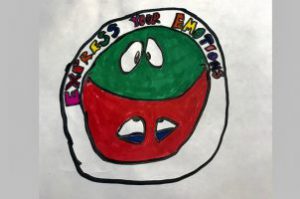Artwork by a Member of an ICT Social Communication Group for Teenagers
Over a decade ago, our co-founder and speech-language pathologist Mandy Alvarez was working in a private practice talking to a parent about speech-language therapy for her son. The parent listened and said, “All of that is important, but I really just want my son to have a friend.” Her words hit home, and Mandy went on to co-found ICT in order to provide therapy with a special emphasis on social communication.
Mandy says that social communication encompasses a wide range of abilities that allow a person to “relate to others and understand the verbal and non-verbal nuances of back-and-forth interaction.” Here’s a snapshot of social communication: You need help finding something at the supermarket, so you approach an employee. You gauge a comfortable distance between you, create a friendly vibe by smiling, and initiate by saying, “Can you please help me find something?” She nods and that’s your cue to go on: “I’m looking for broth.” You know that’s enough information without adding that it’s chicken broth for soup. When she says, “There’s one brand on sale, but you might want to skip it,” and makes a face, you understand her implied meaning is that the on-sale brand doesn’t taste good.
The ability to navigate an interaction like this comes naturally for many of us, but it’s common for kids with language, sensory-motor and other developmental challenges to struggle with social communication. Aside from asking for help at a supermarket, it can be hard for them to build and sustain friendships and navigate social situations like recess, birthday parties, family gatherings, and eating at a restaurant.
Our social communication groups can help kids gain the confidence to maneuver the social world. Here are some of the highlights:
Practice for the Real World
Social communication groups are a stepping stone. They allow kids to practice the skills they learn in individual therapy in a supported environment where they feel successful. This gives them the confidence to take those skills into the real world. Often one of the most valuable things kids take away is a friend whom they continue to see outside of group.
Some of the skills we practice:
- Awareness—being aware of others, how we feel in their presence, and how they might feel.
- Initiating—greeting someone, asking someone to play, starting a conversation, or asking for help.
- Turn Taking—speaking to someone, listening to their response, responding appropriately, or taking turns while playing a game.
- Perspective Taking—Thinking about how another person feels.
- Non-Verbal Cues—Reading and using tones of voice, facial expressions and body movements in communication.
Individualized Placement
Before placing kids in social communication groups, we carefully evaluate them. Some of things we look at are:
Readiness for the group. A child needs a basic understanding of social communication to be able to practice it with others. If a child isn’t ready for that, we spend some time in individual speech-language therapy. One of our favorite methods is Social Thinking™—developed by Michelle Garcia Winner to teach the concepts behind social skills like adjusting behavior to fit a situation and seeing something from another person’s perspective.
Developmental level. Rather than grouping by age, we place kids based on their developmental level, which optimizes their learning. In all of our interventions we meet kids wherever they are on the developmental ladder and start there.
Processing speed. Similar to matching developmental levels, matching the speech at which kids process information is important. One of the main goals of these groups is to teach kids how to talk to each other, so this type of matching ensures they can feel successful practicing conversation skills.
Personality traits. Our Assistant Director of Speech Therapy, Melissa Marinelli Izquierdo M.S., CCC-SLP says that “grouping a dominant child with a non-assertive child benefits both of them. The dominant child learns that his actions may feel like too much to others, and the non-assertive child learns to stand up for himself.”
Real-World Practice for Teenagers
Melissa also facilitates our groups for teenagers, and when they’re ready she offers group members real-world practice. At a restaurant, for example, members can practice things like looking at the server while ordering food, talking to each other during the meal, asking for the check and paying the bill. Similarly, she might take a group to a baseball game one day and a library another. This helps them practice how to match their behavior to different situations. After these outings, Melissa processes with the group: What was hard? What worked? What will you do differently next time?
Above all, our social communication groups are about relationships, which for kids means friends. It is through relationships and friendships that we all learn and grow! For more information about how our groups may help your child, please give us a call.


Recent Comments